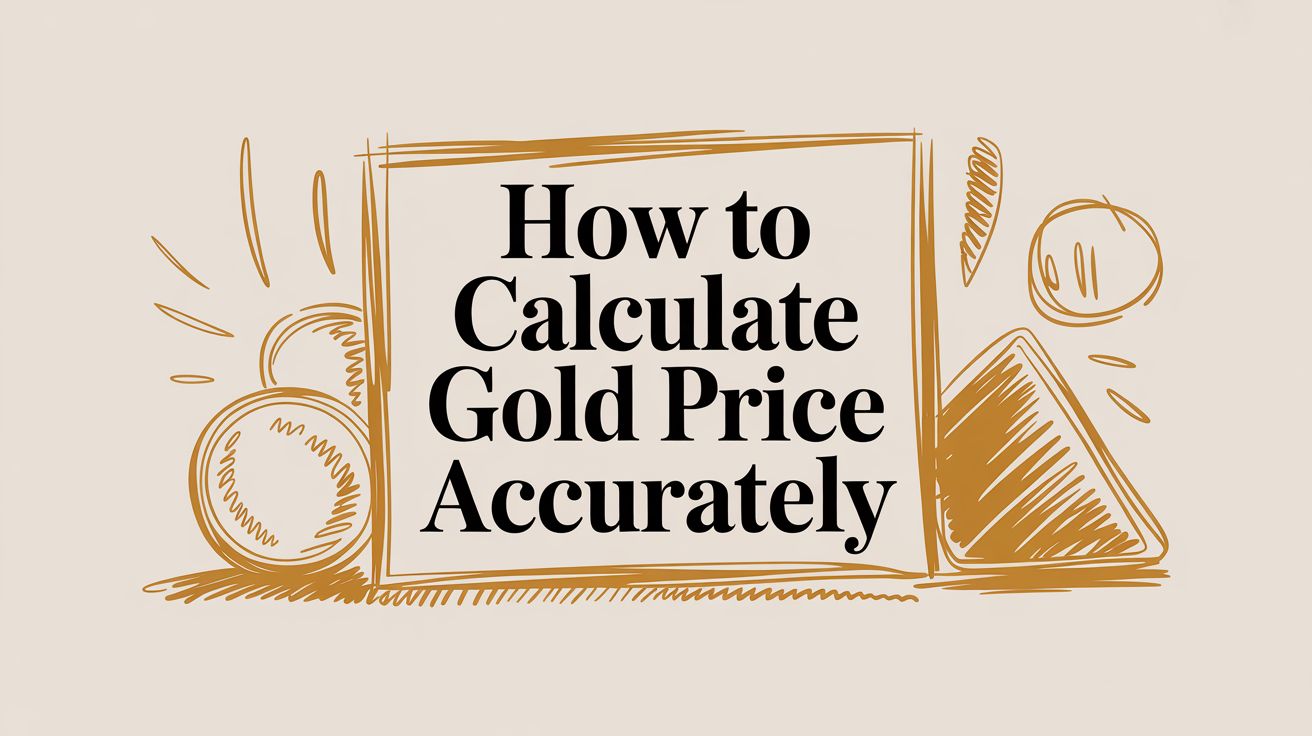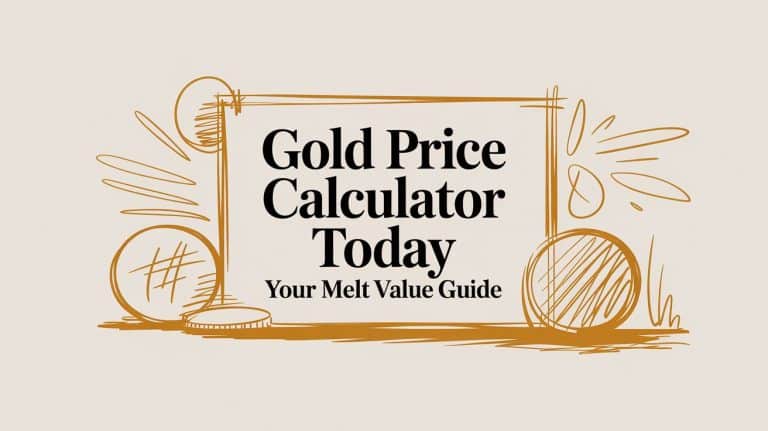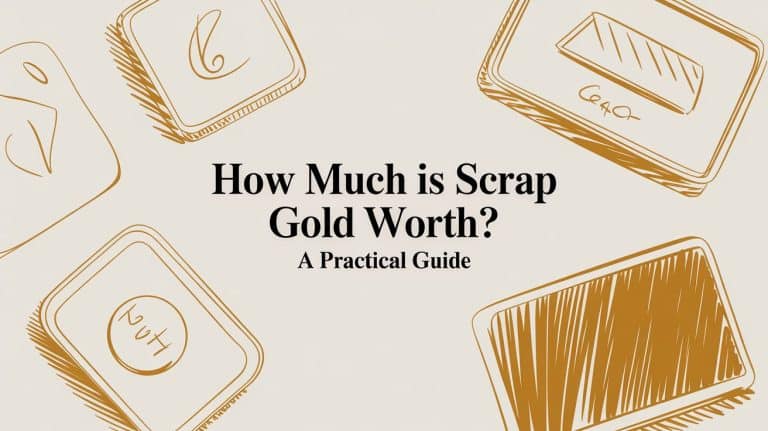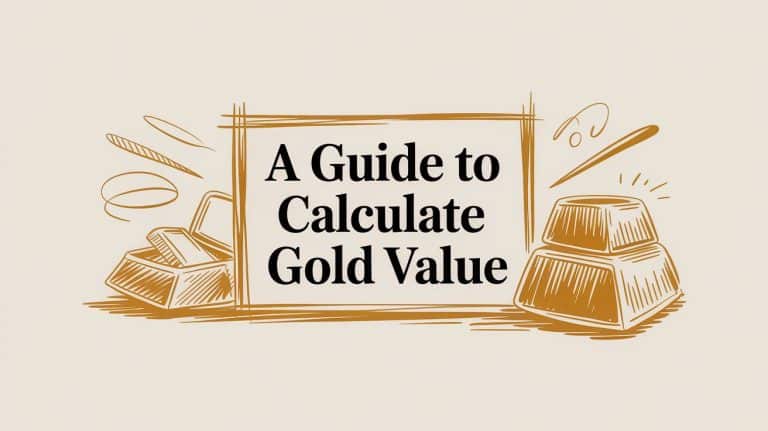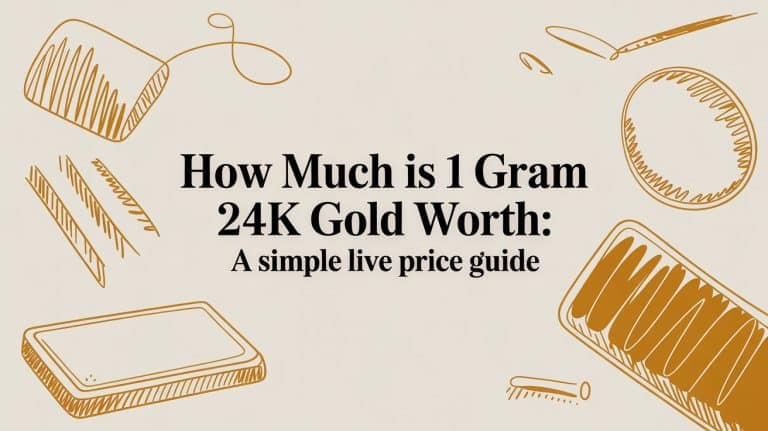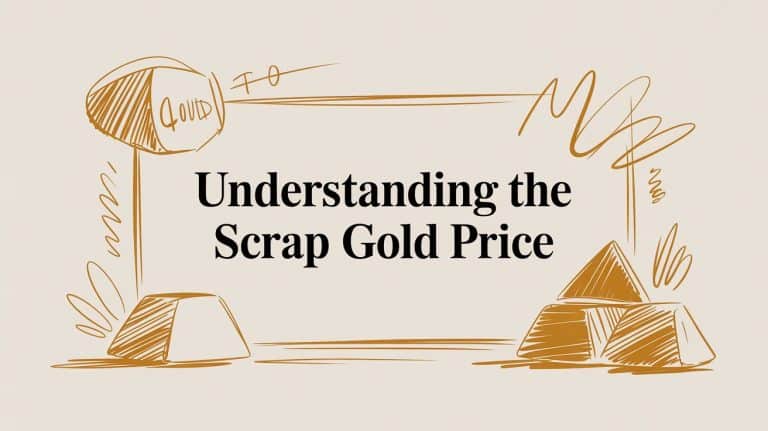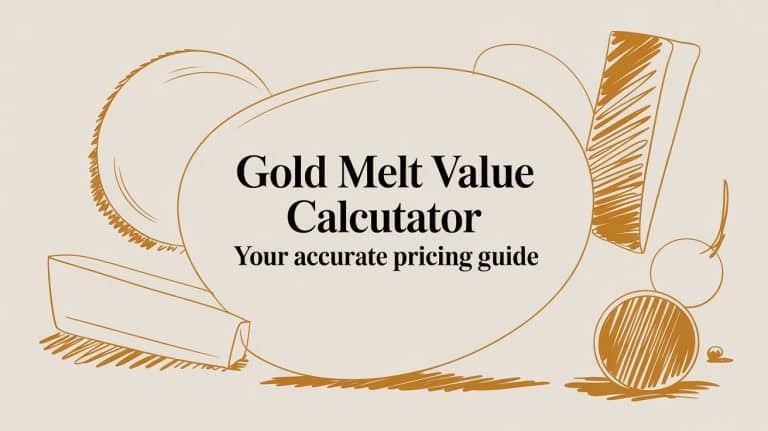How to Calculate Gold Price Accurately
Figuring out your gold’s price really comes down to three things: its weight, its purity or karat, and the current market price of gold. The basic calculation just multiplies these three together to get a solid estimate of its melt value.
Your Quick Guide To Calculating Gold Price
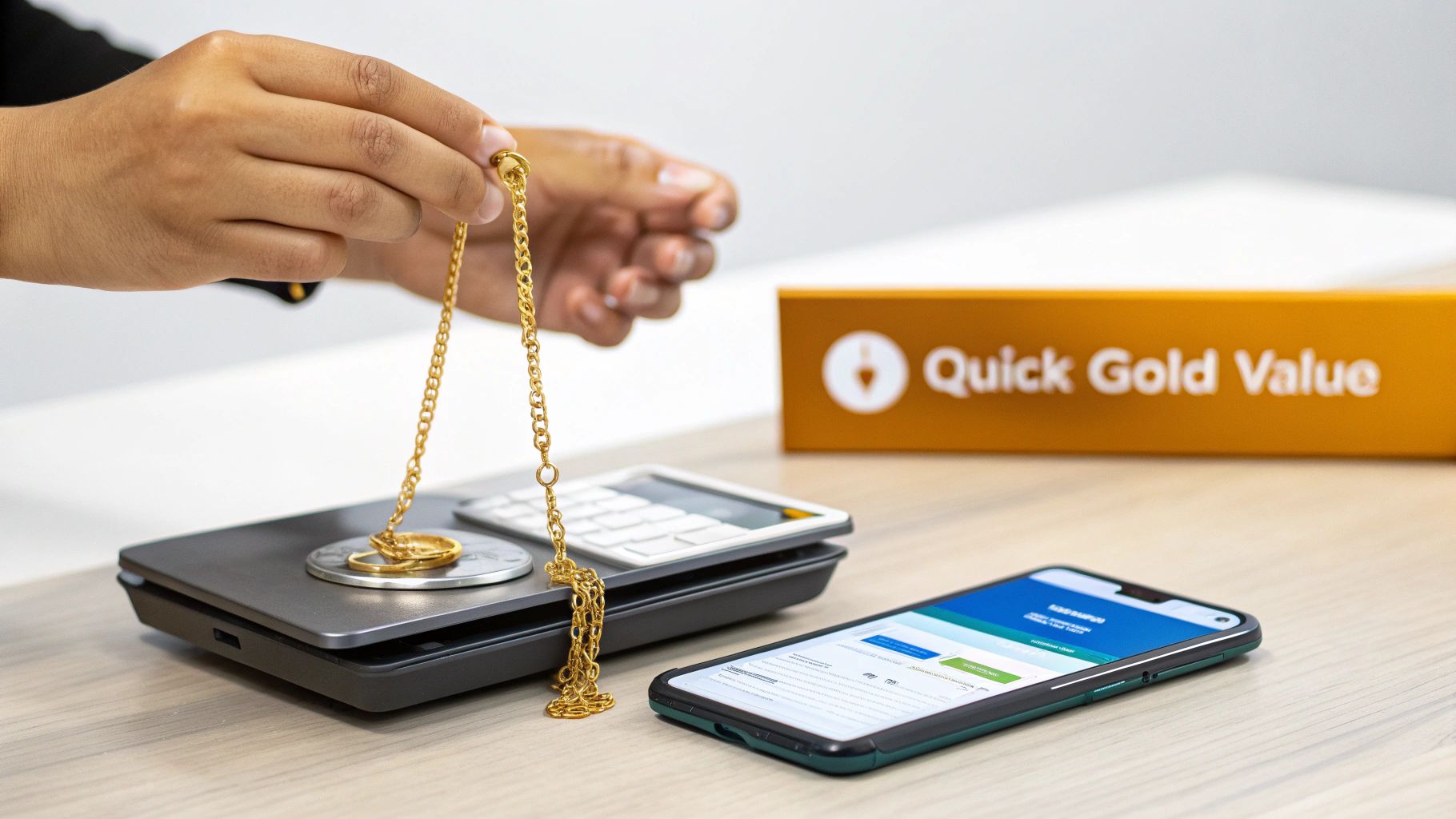
Before you can confidently ask, how much is my gold worth? You absolutely need a reliable starting point. This initial calculation gives you the raw, or melt, value of your gold. This is the baseline number every buyer starts with.
Think of it as the pure commodity value of the actual gold inside your item, completely separate from any artistic design, brand name, or sentimental attachment.
Getting this number right is the most critical first step in the whole process. It arms you with the knowledge to have a meaningful conversation with any potential buyer and helps you set realistic expectations for the offers you will receive.
The Core Gold Value Formula
At its heart, the gold conversion formula is pretty simple:
(Weight of Your Item x Purity Percentage) x Current Spot Price Per Unit of Weight = Estimated Melt Value
Now, this formula looks straightforward, but each part has its own details to get right. For example, the Purity Percentage comes directly from the karat of your gold, and the Current Spot Price has to match the unit of weight you are using, whether that is grams, troy ounces, or something else.
Understanding Purity And Karats
Most gold jewelry is not 100% pure gold. That is because pure, 24 karat (24K) gold is surprisingly soft, so it is mixed with other metals, called alloys, like copper, silver, or zinc to make it durable enough for everyday wear. The karat number tells you exactly how much pure gold is in your item out of 24 parts.
A 14K gold piece, for instance, means 14 parts are pure gold and the other 10 parts are other metals.
To make the formula work, you have to convert this karat value into a simple percentage or decimal. This is a non-negotiable step for getting an accurate result.
Gold Karat Purity Conversion Chart
The table below makes this conversion easy. Just find your item’s karat stamp and use the corresponding decimal in your calculation.
| Karat (K) | Purity Percentage (%) | Decimal for Calculation |
|---|---|---|
| 24K | 99.9% | 0.999 |
| 22K | 91.6% | 0.916 |
| 18K | 75.0% | 0.750 |
| 14K | 58.3% | 0.583 |
| 10K | 41.7% | 0.417 |
With this chart and the basic formula, you now have the tools to calculate a quick, dependable estimate for your gold’s melt value. This number is your foundation as we dig into the more detailed parts of a full valuation.
The Three Pillars of Gold Valuation
To get a true handle on your gold’s value, you need to master three core concepts: the current market price, the item’s purity, and its exact weight. These are not just abstract numbers; they are the fundamental pillars that everything else is built on. Nail these three, and you are well on your way to an accurate calculation.
Think of it like building a house. The spot price is your foundation, the purity is the quality of your materials, and the weight is the square footage. If any one of these is off, the final structure just will not be sound. Let’s break each one down so you can value your gold with real confidence.
Decoding The Gold Spot Price
First up is the spot price. This is the live, up to the minute market price for one troy ounce of pure, 24K gold that is ready for immediate delivery. It is the global benchmark that all gold calculations are based on, and it is constantly changing throughout the trading day.
You will see the spot price jump around based on all sorts of global events, such as supply and demand, inflation jitters, investor sentiment, and currency swings. For example, when inflation starts climbing, investors often flock to gold as a safe haven asset, which pushes demand and prices higher. For a closer look at these market movers, GoldAvenue.com offers great insights on gold price factors.
The bottom line is this: the spot price is a moving target. The price you see at 9 AM could easily be different by noon. Always, always use the most current price you can find for your calculation.
Understanding Gold Purity: Karats and Fineness
The second pillar, and the one that trips most people up, is purity. As we mentioned, most gold items are not 100% pure. They are actually alloys, which just means pure gold has been mixed with other metals to make it stronger and more durable for everyday wear.
This is where you will run into two critical terms: karat and fineness. Let’s break them down.
| Term | What It Means | Example |
|---|---|---|
| Karat | Measures purity in parts out of 24. A classic jewelry term. | A 14K ring is 14 parts pure gold and 10 parts other metals. |
| Fineness | Measures purity in parts per thousand. A more precise, modern term. | A 14K ring has a fineness of 583, meaning it is 58.3% pure gold by weight. |
An 18K gold ring and a 24K gold bar of the exact same size will have wildly different values because the bar contains way more actual gold. Getting your item’s purity right is absolutely non-negotiable. For a deeper dive, check out our guide on how to test gold purity at home.
Weighing Gold The Right Way
Our final pillar is weight, and precision is everything. A tiny error here can throw your final value off by a surprising amount. The precious metals world also uses its own set of measurements that are different from what you would find in your kitchen.
It is crucial to get these units straight, especially since the spot price is quoted in a specific unit, usually the troy ounce.
| Measurement Unit | Equivalent in Grams | Common Use Case |
|---|---|---|
| Gram (g) | 1.0 g | The most common unit for weighing jewelry and scrap gold. |
| Troy Ounce | 31.1 g | The global standard for quoting the spot price of gold. |
| Pennyweight (dwt) | 1.555 g | Often used by jewelers and pawn shops in the United States. |
| Regular Ounce | 28.35 g | Used for food and postage; never use this for gold. |
Look closely at that table. Confusing a regular kitchen ounce with a troy ounce will skew your calculation by nearly 10%. That is a costly mistake. Always make sure the unit you weigh your item in matches the unit used for the spot price. If you weigh your piece in grams, you have to use the spot price per gram, not per troy ounce.
Mastering these three pillars, spot price, purity, and weight, is the bedrock of every single accurate gold valuation.
Putting the Gold Price Formula into Practice
Alright, you have got the basics down: spot price, purity, and weight. Now it is time to connect the dots and see how these three pillars work together. This is where the theory gets real, turning abstract numbers into an actual dollar value for the gold in your hands.
Walking through the calculation with a real world item takes all the guesswork out of it. It builds the confidence you need to know exactly what your gold is worth. The process is the same whether you have a tangled chain, a single earring, or a class ring.
The Simple Formula for Calculating Melt Value
The core formula is refreshingly straightforward. It brings together the three key elements we have already covered. To figure out the melt value of your gold, you will use this simple equation:
(Weight of Your Item in Grams x Purity as a Decimal) x Spot Price Per Gram = Melt Value
The most critical part? Keeping your units consistent. If you weigh your item in grams, you must use the spot price per gram. Mixing up the price per troy ounce with a weight in grams is one of the most common, and costly, mistakes I see people make.
This infographic breaks down the simple, three part process, showing how each piece of the puzzle fits together for a successful valuation.
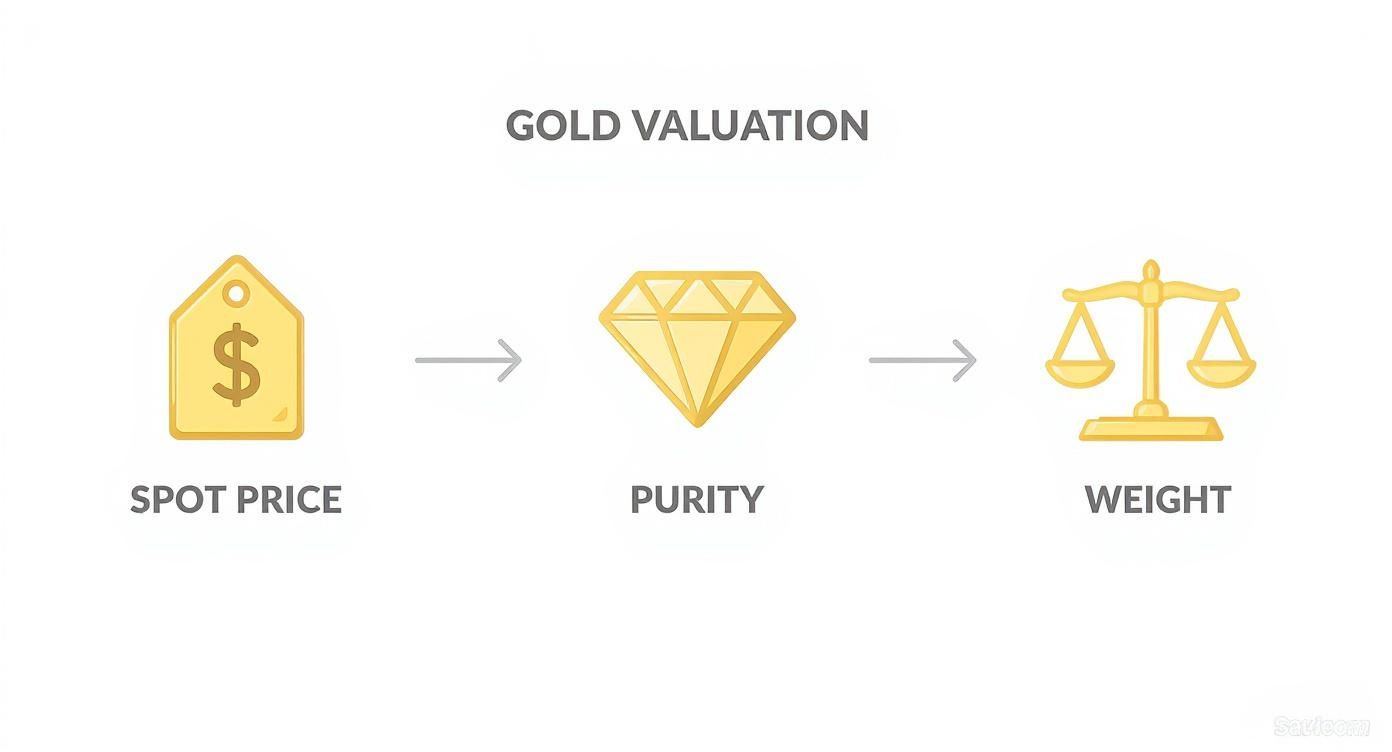
This visual is a great reminder that each element, the live market price, the confirmed purity, and the precise weight, is an essential step on the path to finding the true value.
Example 1: Calculating a 14K Gold Chain in Grams
Let’s apply this formula to a very common piece of jewelry: a 14K gold chain that weighs 15 grams. To make it real, we will use a hypothetical live spot price and watch how the numbers work.
First, let’s gather our data:
- Item: Gold Chain
- Purity: 14K (which is 58.3% pure, or 0.583 as a decimal)
- Weight: 15 grams
- Hypothetical Spot Price: $75.00 per gram
Now, we just plug these numbers into our formula.
- Calculate the Fine Gold Weight: We multiply the chain’s total weight by its purity decimal. This tells us exactly how much pure, 24K gold is in the item.
- 15 grams x 0.583 = 8.745 grams of pure gold
- Calculate the Total Melt Value: With the pure gold weight figured out, we multiply it by the current spot price per gram.
- 8.745 grams x $75.00/gram = $655.88
So, the estimated melt value of that 15 gram, 14K gold chain is $655.88. This number is the raw value of the precious metal itself, before any refining fees or a buyer’s profit margin are factored in.
Example 2: Working with Pennyweights
Sometimes you will run into different units of measurement, especially in the United States where some jewelers still use the pennyweight (dwt). It is an old school unit, but it is simple enough to work with. One pennyweight is equal to 1.555 grams.
The calculation process is exactly the same; you just have to make sure your spot price matches the unit you are weighing in. Let’s calculate the value of an 18K gold ring that weighs 5 pennyweights.
Here is what we know:
- Item: Gold Ring
- Purity: 18K (which is 75.0% pure, or 0.750 as a decimal)
- Weight: 5 dwt
- Hypothetical Spot Price: $116.63 per dwt (This is the direct equivalent of $75.00 per gram)
Let’s run the numbers.
- Find the Fine Gold Weight in DWT:
- 5 dwt x 0.750 = 3.75 dwt of pure gold
- Determine the Total Melt Value:
- 3.75 dwt x $116.63/dwt = $437.36
The estimated melt value for this ring is $437.36. As you can see, the formula is flexible as long as you maintain that crucial consistency between your weight unit and your spot price unit.
If you want to skip the manual math and avoid potential errors, you can always use a reliable scrap gold calculator that handles multiple units instantly. A good online tool does the conversions for you and pulls the latest market prices, ensuring your calculations are always accurate.
Why Your Offer Is Less Than the Melt Value
You have done the math, calculated the melt value of your gold, and you are feeling confident. Then the buyer makes an offer, and it is lower. It is a jolt that nearly everyone experiences the first time they sell scrap gold. But before you feel like you are getting a bad deal, it is important to understand this is not unusual, it is a standard and necessary part of how the gold business works.
That melt value you figured out? Think of it as the raw, theoretical worth of the pure gold locked inside your item. A cash offer, on the other hand, is a real world number. It has to account for all the costs a buyer incurs to actually turn your old jewelry back into that raw, pure gold. Let’s break down exactly what those costs are.
Factoring in Refining and Assaying Costs
The first, and biggest, piece of the puzzle is the cost of refining and assaying. When a pawn shop or jeweler buys your 14K gold chain, they cannot just turn around and sell it on the professional market. It has to be sent, along with heaps of other scrap gold items, to a specialized refinery.
This is a serious industrial process. The items are melted down at extreme temperatures to separate the pure gold from the other alloy metals, the copper, silver, and zinc that gave it durability in the first place. This is the only way to get scrap jewelry back into its pure .999 fine gold bullion form, which is the standard for professional trading. Naturally, refineries charge a fee for this service, and that is a direct cost the buyer has to swallow.
Before the big melt, the refinery performs an assay. This is a highly accurate scientific analysis to verify the exact gold purity of the entire batch. It ensures everyone is dealing with precise numbers, but it is another layer of cost that gets factored into the buyer’s initial offer to you.
The Buyer’s Business Margin
Next up is what is known as the buyer’s operational margin, or simply, their profit. Gold buyers are running a business, complete with real world expenses. These are not just random deductions; they cover the essential costs that allow them to open their doors and provide you with a quick, convenient way to liquidate your gold.
A buyer’s margin has to cover a whole host of necessities:
- Rent and Utilities: The cost of keeping a physical storefront or a secure office running.
- Staff and Security: Paying trained employees who can accurately test gold and ensuring the safety of a very valuable inventory.
- Specialized Equipment: Things like certified scales, acid testing kits, and XRF analyzers are not cheap.
- Market Risk: This one is huge. The spot price of gold can swing wildly. A buyer takes on the risk that the price could plummet between the moment they buy your gold and the time they can actually sell the refined product.
This margin is their compensation for their expertise, the service they are providing, and the very real financial risk they assume with every transaction.
So, What Is a Fair Percentage?
Okay, so what can you realistically expect to walk away with? While there is no single magic number, a reputable buyer will typically offer between 70% to 95% of the melt value. Where you fall in that range depends on a few key things.
| Factor | Impact on Your Offer | Why It Matters |
|---|---|---|
| Quantity of Gold | Higher Percentage | Selling a large amount reduces the buyer’s per gram processing costs, giving them more room to offer you a better rate. |
| Purity (Karat) | Higher Percentage | Higher karat items like 18K or 22K are closer to pure gold, which makes the refining process a bit more efficient and less costly. |
| Buyer’s Business Model | Varies | An online buyer with low overhead might be able to offer more than a pawn shop with expensive retail space. |
| Local Competition | Higher Percentage | If you are in an area with lots of gold buyers, they are all competing for your business, which can drive offers up. |
Understanding how much scrap gold is worth in a real transaction is about looking beyond just the spot price. When you know to expect these deductions for refining and business operations, you can evaluate an offer from a position of strength. An offer of 85% of the melt value, for instance, is often considered very strong and fair. This knowledge empowers you to know a good deal when you see one and negotiate with confidence.
Common Mistakes in Gold Calculation to Avoid
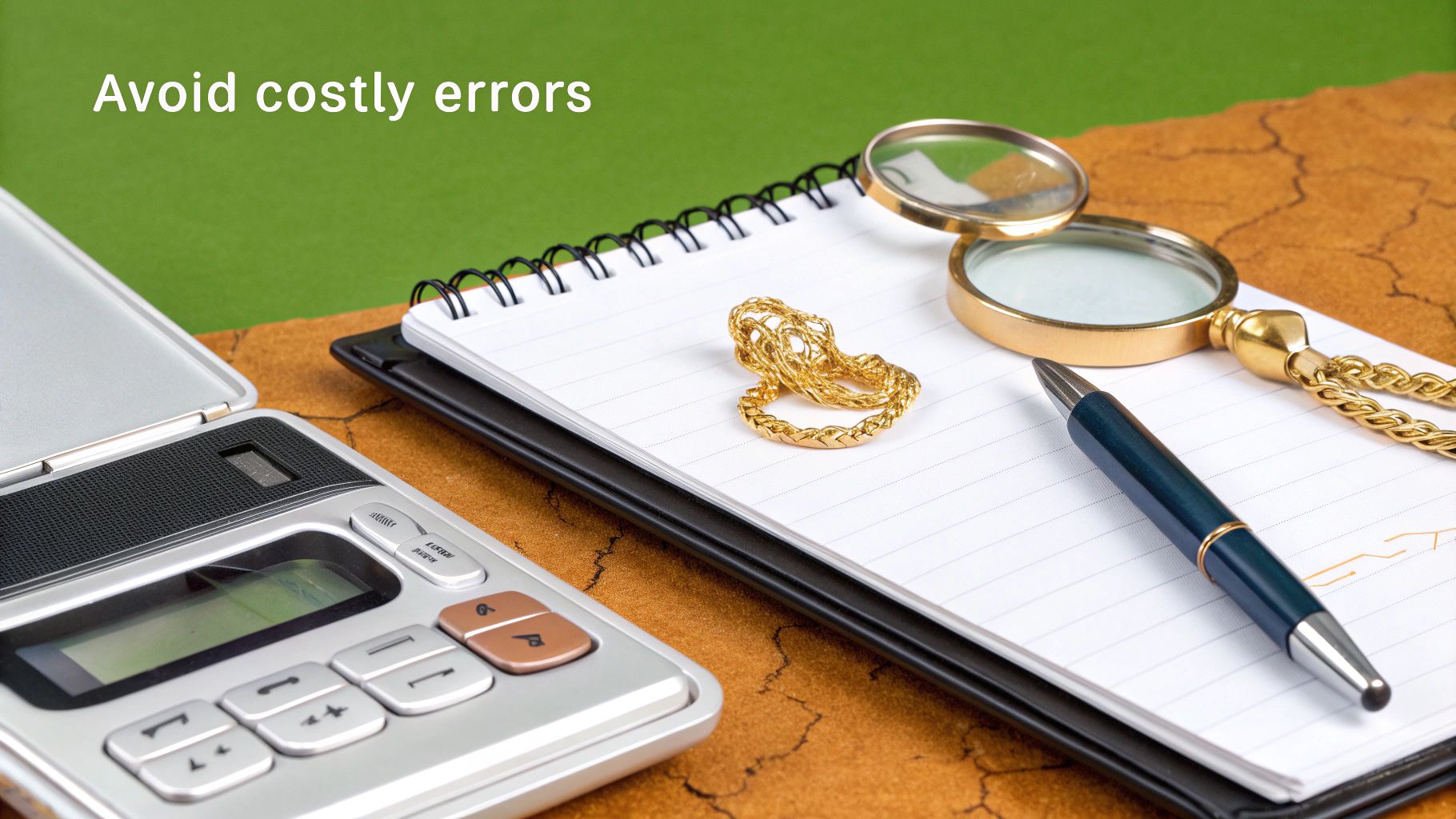
A tiny error when you calculate gold’s melt value can snowball into a significant miscalculation. It’s surprisingly easy to make a small slip-up that throws your numbers way off, but dodging these common pitfalls is simple once you know what to watch for.
Think of this as your pre flight checklist for accuracy. Getting these details right is the difference between making a rough guess and a reliable valuation, which is exactly what you need to walk into a negotiation with confidence. Each point here comes from a real world scenario where people often lose money, not from being tricked, but from a simple oversight.
Confusing Ounces a Costly Error
One of the most frequent, and expensive, mistakes is mixing up a standard kitchen ounce with a troy ounce. It’s an easy mistake to make, but the two are not the same.
- A regular ounce (technically an avoirdupois ounce) is what you use for cooking or postage. It weighs 28.35 grams.
- A troy ounce is the universal standard for precious metals, weighing a heavier 31.1 grams.
The global spot price of gold is always quoted in troy ounces. If you weigh your gold on a kitchen scale in regular ounces and punch that number into a calculator using the troy ounce price, your final value will be off by nearly 10%. On a $1,000 valuation, that’s a $100 mistake. Always double check that your weight unit matches the spot price unit.
Forgetting to Account for Gemstones
Jewelry often includes beautiful gemstones, from tiny accent diamonds to a large centerpiece. While these stones absolutely add to the item’s retail price, they have no place in a scrap gold calculation. The weight you use must be for the gold content alone.
Imagine you have a gold ring with a 1 carat diamond. That diamond weighs 0.2 grams. If the entire ring weighs 5 grams on your scale, you must subtract the stone’s weight before you do anything else. Your actual gold weight is 4.8 grams, not 5 grams. Forgetting this step will artificially inflate your gold’s value and lead to disappointment when you get a real offer from a buyer, who will always weigh the gold separately.
When you are calculating melt value, you are only interested in the weight of the metal itself. For an accurate figure, always subtract the estimated weight of any non gold components like diamonds, pearls, or other gems.
Using an Uncalibrated or Imprecise Scale
Precision is everything when weighing gold, and not all scales are created equal. Using a standard kitchen scale might give you a ballpark figure, but it’s rarely accurate enough for a reliable valuation. Those scales are designed for larger quantities and can have a margin of error that’s massive when dealing with small, valuable items.
A calibrated jeweler’s scale, which measures to at least a tenth of a gram (0.1g), is the professional standard for a reason. These scales are built for precision at low weights, ensuring your starting number is dead on. An uncalibrated or imprecise scale can easily be off by half a gram or more, which directly chips away at your final calculated value.
Looking at historical trends is also valuable when you calculate gold price for investment purposes. Gold prices have hit major peaks, like in 1980 and again in 2011 when they approached $2,000 per ounce. When you analyze these trends with inflation adjustments, you get a much clearer picture of gold’s long term purchasing power. You can explore more about these historical patterns and learn how gold’s value has evolved over time on ionides.github.io.
By steering clear of these three common errors, your journey to an accurate gold price calculation will be much smoother and far more reliable.
Answering Your Top Gold Valuation Questions
We have covered the core formulas and the common mistakes, but a few key questions always come up when you start crunching the numbers on gold. Getting these answers straight will give you the confidence to handle specific scenarios and really understand the bigger picture of gold valuation. Think of this as the final piece of the puzzle, clarifying the market forces and standards that shape your gold’s true worth.
How Does The US Dollar Affect Gold Prices?
Gold is priced in US dollars on the global market, which creates a fascinating and direct inverse relationship between the two. When the value of the US dollar weakens, it literally takes more dollars to purchase one ounce of gold, causing gold’s price to rise. It’s a simple matter of purchasing power.
Conversely, when the dollar strengthens, you need fewer dollars to buy that same ounce, so the price of gold tends to fall. This dynamic is a major reason why big US economic news, like inflation reports or interest rate changes from the Fed, can have an immediate and visible impact on the daily spot price. A weaker dollar also makes gold cheaper for foreign investors, which can boost demand and drive the price up even further.
What Is a Troy Ounce vs. a Regular Ounce?
This is one of the most critical distinctions in the entire process, and confusing the two is a costly mistake. A regular ounce, technically called an avoirdupois ounce, is what you use for weighing food in the kitchen. It equals 28.35 grams.
Precious metals, however, are universally measured in troy ounces, which are heavier at 31.1 grams. The global spot price is always quoted per troy ounce. Using the wrong ounce in your calculation will throw off your final value by nearly 10%.
| Unit of Measurement | Weight in Grams | Primary Use Case |
|---|---|---|
| Troy Ounce | 31.1 grams | The global standard for weighing precious metals like gold and silver. |
| Regular Ounce | 28.35 grams | A common household unit used for food and postage; never for gold. |
Why Don’t Buyers Pay The Full Spot Price for Jewelry?
The spot price represents the market value for a troy ounce of pure, 24K gold, typically traded in large, standardized bars. When you sell scrap jewelry, the buyer has to cover the costs of turning that item back into its pure, raw form.
This industrial process, known as refining, involves melting the jewelry at high temperatures to separate the pure gold from the other alloy metals like copper or zinc. The difference between the spot price and the cash offer you receive covers these refining fees, assaying costs, business overhead, and the buyer’s own profit margin.
Bottom line: No reputable buyer will ever offer 100% of the spot price for scrap gold because of these unavoidable business costs.
How Is Historical Data Used to Analyze Gold Prices?
While the live spot price is essential for an immediate sale, historical data is crucial for investors trying to understand gold’s long term performance. Analysts use statistical models to study past price movements, looking for trends and connections to economic events like inflation, recessions, or changes in interest rates.
For an investor, calculating the inflation adjusted return on gold over several decades helps them evaluate its effectiveness as a long term store of value. These historical calculations provide the essential context for understanding gold’s role in a diversified portfolio, even though past performance can never predict future results.
Ready to put your knowledge to the test without the manual math? The Gold Calculator provides instant, accurate valuations based on live market data. Our free gold calculator tool helps you calculate your gold’s value in seconds, empowering you to make informed decisions with confidence.


